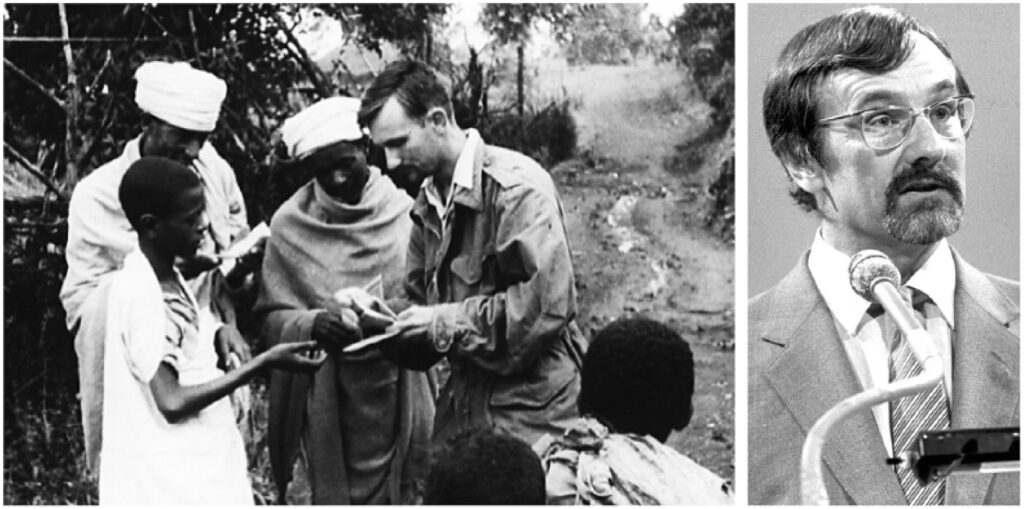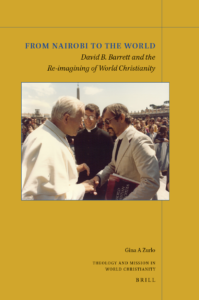by Gina A. Zurlo, Ph.D. – Co-Director – Center for the Study of Global Christianity
This post is part of The Occasional’s “Numbers and Trends” series, dedicated to sharing work, analysis, and perspectives from our friends and partners at the Center for the Study of Global Christianity based at Gordon-Conwell Theological Seminary.
In the early 1980s, David B. Barrett (1927–2011) was on his way to the Soviet Union from Nairobi, Kenya, when he was stopped and detained by the KGB. The trained aeronautical engineer and ordained Anglican priest had spent years conducting research on church affiliations in Kenya, a venture that quickly expanded to encompass religious affiliations of all types throughout Africa and eventually worldwide. It was this riveting quest that had Barrett in search of the best available data on Christianity under Communism in the Eastern bloc. Under his arm was the manuscript of the 1,000-page World Christian Encyclopedia, with detailed information on Christian communities in every country of the world. The manuscript was closely inspected for secret microdot markings used by spies. Fortunately for Barrett, the KGB officers were so preoccupied with making sure he was not a spy that they failed to notice the in-depth descriptions of underground Christian activities in the USSR.[1]

In July 1965, Barrett – the founder of what would become the Center for the Study of Global Christianity (CSGC) – launched the Unit of Research of the Church of the Province of East Africa. The CSGC’s first iteration was housed in the headquarters of the Anglican church in Nairobi, Kenya. Its original purpose was for research, study, and communication on religion in society in East Africa and beyond. The Unit of Research was primarily concerned with the sociological study of religion and its relation to the churches of East Africa.
The first edition of the World Christian Encyclopedia (Oxford University Press) was produced in 1982 after 14 years of research and travel to 212 of the world’s 223 countries. From a context of significant social, political, and cultural change, the WCE described a diverse and fragmented World Christianity. It contained information on 20,800 Christian denominations in every country of the world and represented 8,990 people groups who spoke 7,010 languages. This text presented, for the first time, a comprehensive quantitative assessment of all branches of global Christianity. The media, scholars, and mission researchers hailed it as a vital resource. In a 1982 TIME magazine article, journalist Richard Ostling called the WCE “a miracle from Nairobi” and Barrett “the Linnaeus of religious taxonomy.”[2]
The most remarkable achievement of the World Christian Encyclopedia was the complete enumeration of the entire religious and non-religious worlds for the first time in history. Many people, especially Western academics, thought Christianity was in total decline in the face of Communism and what they perceived as “global” secularizing trends. Sociologists predicted the near demise of religions by the year 2000.[3] Barrett, however, estimated 350 million Christians in Africa by the year 2000 – and was right.[4]

Until now, no historical assessment has been made of how and why Barrett was able to quantify the entire world. A book on the subject was released in March 2023, From Nairobi to the World: David B. Barrett and the Re-imagining of World Christianity (Brill). The primary sources for this project were the archives at the Center for the Study of Global Christianity at Gordon-Conwell Theological Seminary in South Hamilton, Massachusetts, USA. The archives include Barrett’s personal papers including day diaries, notes from missionary training and graduate studies, hand-written drafts of the World Christian Encyclopedia, and data he collected during the production of the WCE. The jewel of the archives were the chronologically organized binders that contain carbon copies of nearly every letter Barrett wrote and received between 1957 and 1985, assembled by himself in Nairobi, totaling in the tens of thousands. These primary sources were used to construct the history of Barrett’s pioneering work, which revealed a much more dramatic story than one might expect. The 14-year production of the WCE was the product of a global, ecumenical collaboration seemingly doomed from the start, in the context of a world adjusting to post-colonial realities and advances in computing technology. From Nairobi to the World is much more than just the history of an encyclopedia. It places Barrett in the historiography of World Christianity and highlights the importance of quantification – particularly in Africa – in the construction of our contemporary understandings of World Christianity.
—
[1] See Gina A. Zurlo, “The Legacy of David B. Barrett,” International Bulletin of Mission Research 42 no. 1 (October 2018): 29–39.
[2] Richard N. Ostling, “Counting Every Soul on Earth: A Miracle from Nairobi: The First Census of all Religions,” TIME, May 3, 1982, 66–67.
[3] See Peter Berger, “A Bleak Outlook is Seen for Religion,” The New York Times, April 25, 1968, page 3.
[4] David B. Barrett, “AD 2000: 350 Million Christians in Africa,” International Review of Mission 59, no. 233 (January 1970): 39–54.




